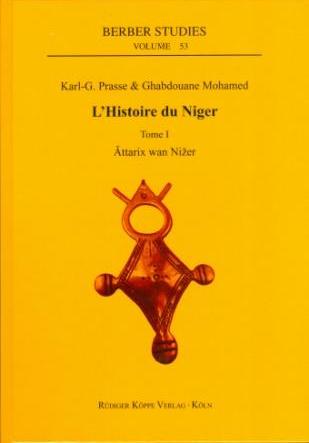
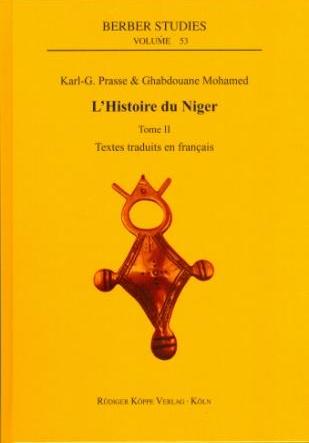
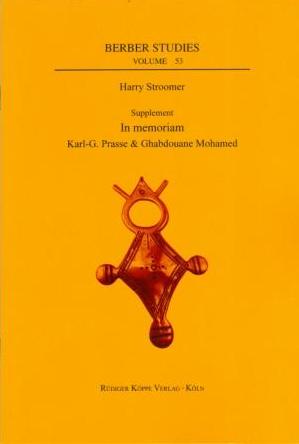
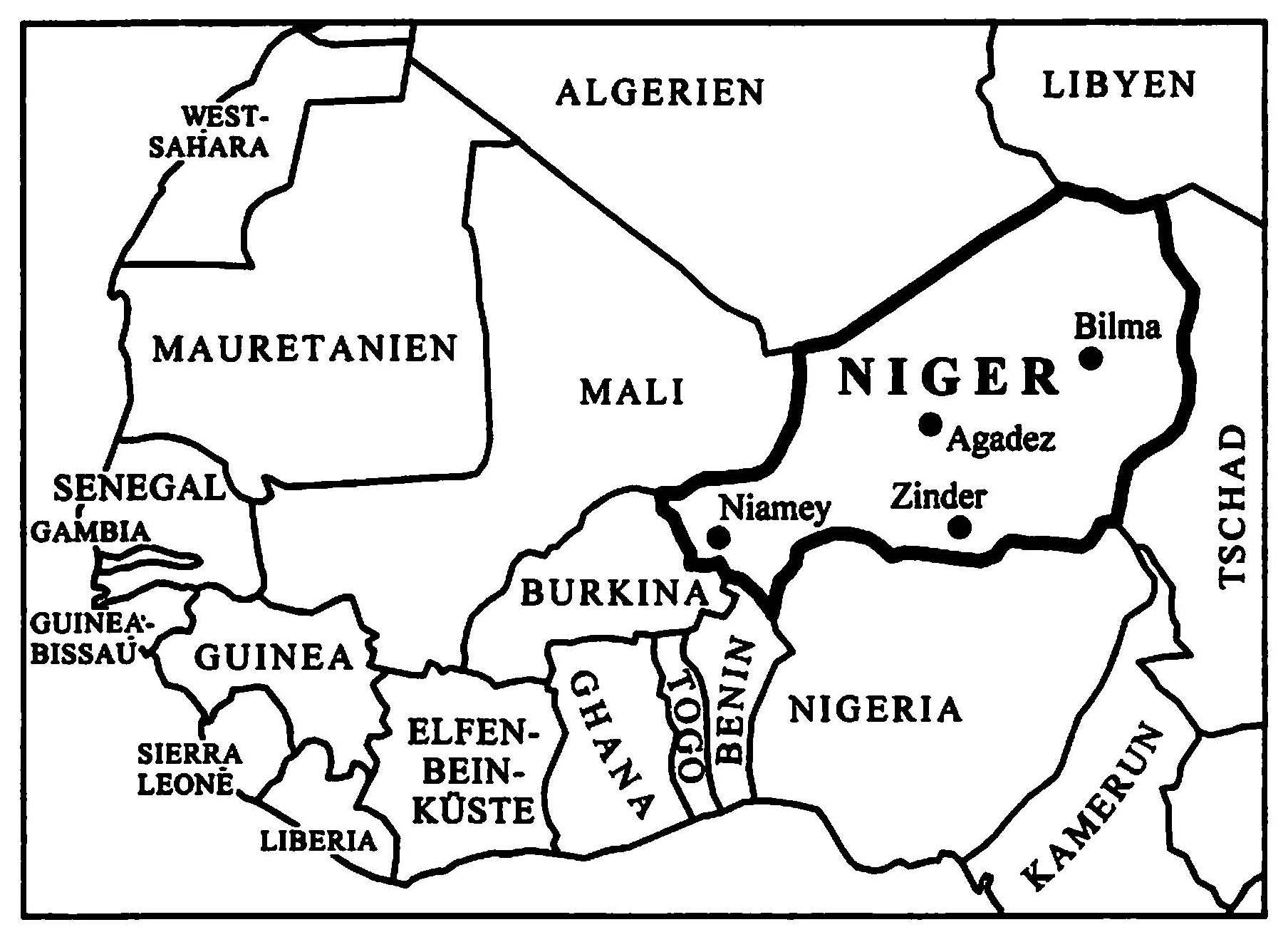
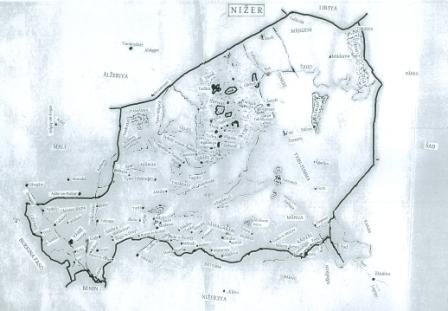
L’Histoire du Niger, transcrit du touareg de l’Ayr
Tome I: Ăttarix wan Nižer, dəɣ təmažəq tann Ayər. Textes berbères originaux en touareg de l’Ayr – Tome II: Textes traduits en français – Supplement by Harry Stroomer: In memoriam Karl-G. Prasse and Ghabdouane Mohamed
Author: Karl-G. Prasse †, Ghabdouane Mohamed †. Edited by: Harry Stroomer. With a supplement by: Harry Stroomer. Series edited by: Harry Stroomer.
Series: BS Berber Studies Volume 53
2019467 pp.
2 maps in the main volumes, numerous charts and overviews of historical stages, appendix, index, 3 colour photos in the supplement volume
Text language(s): French, English
Format: 170 x 240 mm
1160 g
Hardcover
€ 98.00
Buy 'L’Histoire du Niger, transcrit du touareg de l’Ayr' as a downloadable PDF document directly from our online shop »
Order 'L’Histoire du Niger, transcrit du touareg de l’Ayr' as print edition »
The present monograph covers the history of the Republic of the Niger representing the perspective of the Tuareg people. At the same time, it includes the world’s longest written Berber text. The work consists of three volumes – one original-language Tuareg version and its respective translation into French. The text language is Tayərt, a Berber dialect spoken in the Ayr Mountains. Mainly, the authors present the events from the point of view of the Tuareg; nevertheless, the historical development of the other Nigerien peoples are mentioned and embedded in the descriptions as well. The supplement volume features an obituary by Harry Stroomer on both authors of the main volumes who passed away in 2018.
First of all, there is an insight into human history, originated in Africa, provided, before the authors deal with the origin and the prehistory of the Berber people. Starting with the first written sources of Tuareg-history (around 700 A.C.), the authors subsequently summarise the development of the people up to the end of the 20th century:
700-1400: Invasion of southern Algeria and the Nigerien Ayr Mountains by the Tuareg. Foundation of the first Kanuri Empire (Kanem).
1400-1600: The sultanate of Ayr, the Songhai Empire, and the second Kanuri Empire (Kanem-Bornu).
1600-1800: A period without a large neighbouring empire. The Tuareg had significant influence on the Nigerien territory at that time.
1800-1900: Rise and fall of the Sokoto Caliphate of the Fulani (the city of Sokoto is situated in today’s Nigeria). Arrival of the first European colonialists.
1900-1920: Resistance against the colonial power, especially that of the Tuareg people.
1920-1960: Colonial era in Niger.
1960-2000: From independence to a modern state.
Review of the volume by Stanly Oomen
Review of the volume by Lameen Souag
Under this link you will find further festschrifts and obituary volumes for renowned scholars published in our programme.
Under the following links you will find descriptions of further Nigerien languages and cultures, as well as publications of the authors:
Accompanying material:
- A Grammar of Ayer Tuareg (Niger)
(ISBN 978-3-89645-930-5 ) - Hirtenarbeit
(ISBN 978-3-89645-206-1 ) - Le tetserret, langue berbère du Niger
(ISBN 978-3-89645-938-1 )
Cross-reference:
- Alltägliche Zauberei
(ISBN 978-3-89645-310-5 ) - Brunnen und Felder
(ISBN 978-3-89645-895-7 ) - Das Dogma der Partizipation
(ISBN 978-3-89645-820-9 ) - Tuareg Elementary Course (Tahaggart)
(ISBN 978-3-89645-929-9 )
Reviews
<1> A shortsighted reader might dismiss Niger as peripheral; at present, it is a strong contender for poorest country in the world, familiar to Westerners mainly from headlines about insurgency or famine. Yet this very rapidly growing country (approaching 26 million people as of 2022) supplies a third of the uranium that fuels the nuclear power plants of its former colonial ruler France, mined almost entirely in the predominantly Tuareg north. Their region is home to some of the oldest written records in West Africa, and has played a key role in the trans-Saharan trade perhaps as far back as Herodotus, making it central to relations between the Mediterranean and West Africa and to the emergence of premodern concepts of race in western Eurasia. Its history should be of interest, not just to students of West Africa, but to anyone seeking to understand how the modern world works and how it got that way.
<2> The book reviewed here presents the history of Niger – more particularly, the history of the Tuareg people of Niger – from the perspective of a leading European student of their language and culture, Karl-G. Prasse, in collaboration with a Tuareg scholar and politician from Amataltal, Ghabdouane Mohamed. According to its preface, it draws especially upon the work of Yves Urvoy and André Salifou; apart from the works listed in its bibliography, specific sections also reflect collaboration with Ahmed Mika’il, Issouf Hadane, and Ismaghile Ilitnine. The work appears in two languages: Tayart Tamajeq (the language of the Tuareg of the Air Mountains), and French. It would be presumptuous for this reviewer to comment in any detail on the Tamajeq version; Prasse’s customarily careful transcription makes it a valuable resource for foreign students of Tamajeq as well as for Tuareg readers, despite the unavoidable use of neologisms some of which may not be widely known. A detailed summary of the contents based on the French version, however, is provided below for the benefit of interested Anglophones, with occasional critical remarks. The two volumes are followed by a short pamphlet containing obituaries of the two authors, both deceased in 2018, along with a bibliography of Karl-G. Prasse’s works, vital for any student of Berber linguistics.
[Vollständiger Text / complete review:]
Lameen Souag in Afrikanistik-Ägyptologie.online, 2022, 1-5
| « back | Print version | [top] |
 Books
Books Audio
Audio Biographies
Biographies Series
Series Festschrifts
Festschrifts Journals
Journals